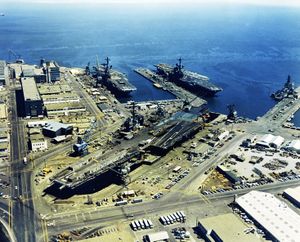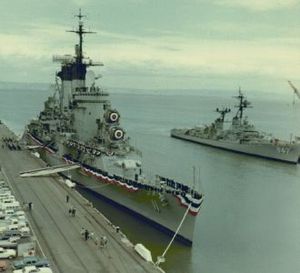Hunters Point
Click here for World War II History category page |
The San Francisco Naval Shipyard was a United States Navy shipyard in San Francisco, California, located on 638 acres (2.6 km2) of the waterfront at Hunters Point in the southeast corner of the city. Originally, Hunters Point was a commercial shipyard established in 1870, consisting of two graving docks purchased and upbuilt in the late nineteenth and early twentieth century by the Union Iron Works company, later owned by the Bethlehem Shipbuilding Company, located at Potrero Point.
The original docks were built on solid rock. In 1916, the drydocks were thought to be the largest in the world, for the time. At a length of over 1000 feet, they were said to be big enough to accommodate the largest warships and passenger steamers afloat. Soundings showed an offshore depth of sixty-five feet. The Navy used the docks as a mid-site between San Diego and Bremerton, Washington. Much of the shoreline was extended by landfill extensions into the San Francisco Bay during the early 20th century. The Navy recognized the importance of shipbuilding and repair in the San Francisco bay and began negotiating for use and appropriation of the Hunter's Point Drydocks during World War I. A Congressional hearing on Pacific Coast Naval Bases was held in San Francisco in 1920 at San Francisco City Hall where city representatives, Mayor Rolph, City Engineer O'Shaughnessy, and others testified on behalf of permanently using Hunters Point by the Navy.
The land was again appropriated by the United States Navy at the onset of World War II and became one of the major shipyards of the West Coast. The Navy reacquired it in November 1941, later renaming it Hunters Point Naval Shipyard, then Treasure Island Naval Station Hunters Point Annex, and operated the yard until 1974, when it leased most of it to a commercial ship repair company. Many workers, including African Americans, moved into the area to work at this shipyard and other wartime-related industries in the area. After the war, the area remained a naval base and commercial shipyard, as many blue-collar industries moved here. The Navy closed the shipyard and Naval base in 1994 as part of the Base Realignment and Closure (BRAC). The BRAC program manages the majority of the site to this day. As in most industrial zones of the era, Hunter's Point has had a succession of coal and oil-fired power generation facilities, and these have left a legacy of pollution, both from smokestack effluents and leftover byproducts that were dumped in the vicinity. The base was entirely closed in 1994, although it continues to receive attention due to the large amounts of toxic waste remaining to be cleaned up.
After WWII and until 1969, the Hunters Point shipyard was the site of the Naval Radiological Defense Laboratory, the US military's largest facility for applied nuclear research, which has left many areas of the shipyard radioactively contaminated.
The Hunters Point shipyard has recently been targeted as a possible location for a new San Francisco 49ers stadium, but then again, no.
A Personal Note from Robin
I was part of the pre-commissioning crew of the USS Chicago which was refitted at Hunters Point in the mid-60s. While stationed aboard the Chicago, I was commuting to my parents home at in Sunnyvale CA at night and on weekends
What links here • References and Sources • Help • Contact info • Category:Root ⤴

